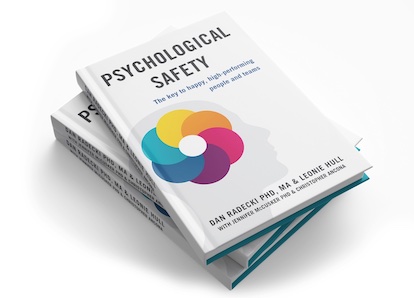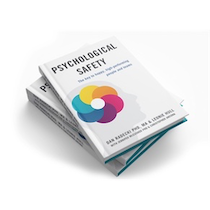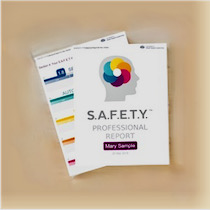Implementing psychological safety in the workplace is crucial for fostering a culture of innovation and engagement. In this article, we unpack ten potential pitfalls to avoid, ensuring that your path is built on a solid foundation, strategically applied, and sustainable for the long term.
-
No Science-backed, Research-driven Foundation
Why It Matters: Initiatives aimed at implementing psychological safety within an organization must be anchored in a robust, science-backed foundation. This not only enhances their effectiveness but also equips leaders with the evidence needed to foster buy-in and commitment at all levels.
-
Focus on Awareness Generation, Not Application
Why It Matters: While raising awareness about psychological safety needs is important, it’s not sufficient on its own. To make a tangible impact, initiatives must include actionable steps that integrate the principles of psychological safety into the fabric of daily interactions and decision-making processes.
For example, managers and teams could be provided with comprehensive training that educates on recognizing potential triggers — both within themselves and in interactions with others. By focusing on the application when implementing psychological safety, we move from simply knowing to doing, which is where the real transformation happens.
-
No Shared Framework, Understanding, and Language
Why It Matters: A shared framework ensures that all employees, regardless of their role or seniority, have a mutual compass for navigating the nuances of psychological safety.
This common ground lays the foundation upon which trust, openness, and innovation can be built. Establish clear definitions and concepts that everyone in the organization can understand and apply.
-
Responsibility and Accountability is Not Shared
Why It Matters: Psychological safety is not the sole responsibility of leadership; it’s a collective effort. When accountability is democratized, psychological safety becomes the collective heartbeat of the organization, driving it towards greater innovation, resilience, and success.
To foster a truly safe and open culture, each member of the organization must be empowered and encouraged to take ownership, champion implementing psychological safety, and hold one another accountable.
-
Unverified Assessments, Diagnostics, and Tools
Why It Matters: For psychological safety measures to truly resonate and effect change within an organization, it’s essential to utilize assessments, diagnostics and tools that have been proven reliable and valid.
This ensures that interventions are informed by accurate data, providing a clear and truthful reflection of the organization’s psychological safety climate, and allowing for targeted, strategic actions that genuinely foster a culture of safety and wellbeing.
-
No Focus on How to Identify, Understand, and Articulate Psychological Safety Needs
Why It Matters: If individuals are unsure of how to identify and express their needs, or if the organization lacks the channels for such expression, the foundation of psychological safety is weakened.
Training that empowers employees to articulate their needs is not just beneficial but vital. It paves the way for a culture where psychological safety is actively sought and maintained, creating a workforce that is not only aware of its needs but also proficient in communicating them.
-
Lack of Psychological Safety Strategies to Manage Diverse Needs
Why It Matters: A monolithic approach to implementing psychological safety is likely to miss the nuances that make each individual and team unique. Instead, developing a suite of flexible, adaptive strategies that can be tailored to fit various groups and individuals is key to ensuring everyone feels truly safe.
This approach allows for the creation of an inclusive environment where all team members can thrive. By doing so, organizations not only uphold the principle of psychological safety but also harness the rich potential that comes from a truly diverse workforce.
-
Trigger Identification and Management Not Addressed
Why It Matters: Identifying and managing triggers that compromise psychological safety is as critical as establishing safety itself. Without recognizing these triggers, an organization leaves its employees vulnerable to repeated stressors that erode trust and openness.
By proactively addressing triggers, organizations can create an environment where issues are resolved swiftly and empathetically, reinforcing a culture of safety and ensuring that all team members feel supported and understood. This proactive approach not only mitigates immediate risks but also contributes to the long-term resilience and emotional intelligence of the workforce.
-
No Ongoing Measurement, Reinforcement & Sustainability
Why It Matters: Continuous measurement is paramount to understanding the effectiveness of interventions and identifying areas needing improvement. This commitment to regular assessment ensures that psychological safety becomes ingrained in the company culture, rather than a fleeting trend.
Reinforcement through follow-up training, refreshers, and communications solidifies the learning, and improves the sustainability of psychological safety within the workplace, helping make the principles take root deeply within the organizational structure.
-
Lack of Proven Implementation System
Why It Matters: Without a structured implementation system, there’s a significant risk that efforts will dissipate before they even begin to impact the organizational culture.
A systematic approach means setting clear benchmarks and milestones. It involves mapping out a step-by-step plan, from initial awareness campaigns to the integration of psychological safety practices into everyday work life.
A structured implementation system ensures that psych safety becomes more than just an intention—it becomes a tangible, measurable part of the organizational journey towards a more supportive and high-functioning workplace.
The ABL Approach to Building Psychological Safety
The Academy of Brain-based Leadership (ABL) recognizes that building a workplace culture that fosters safety is a nuanced and multifaceted challenge that demands an equally sophisticated response. Informed by the tenets outlined above, our approach marries rigorous, science-based research with practical, actionable strategies, ensuring a robust and resilient implementation of psychological safety in the workplace.
We believe in the power of shared frameworks, underpinned by a common language that every member of an organization can access and utilize. Through validated assessments and continuous, open channels for feedback, we facilitate a deep understanding of psych safety needs, tailored to accommodate the rich diversity of teams. Our methods encompass proactive identification and management of triggers, fostering an environment where individuals feel supported to express concerns and share ideas without fear of retribution.
Ongoing measurement and reinforcement are cornerstones of our strategy, ensuring that the principles of psychological safety are not only adopted but also integrated and sustained over time. By providing a structured system for implementation, complete with clear benchmarks and milestones, ABL’s approach ensures that initiatives gain traction and yield long-lasting, transformative results.
Embracing these principles, ABL is committed to partnering with organizations on their journey toward a safer, more engaged, and more productive workplace, where psych safety is not just a goal but a reality for all.
Next Steps
Contact our team to discuss your organization’s needs today
Watch our on-demand webinar about Building a Culture of Psychological Safety
Learn about our neuroscience-backed S.A.F.E.T.Y.™ Model & Assessment
Get a Psychological S.A.F.E.T.Y.™ Accreditation as a Leader, Coach or Consultant














